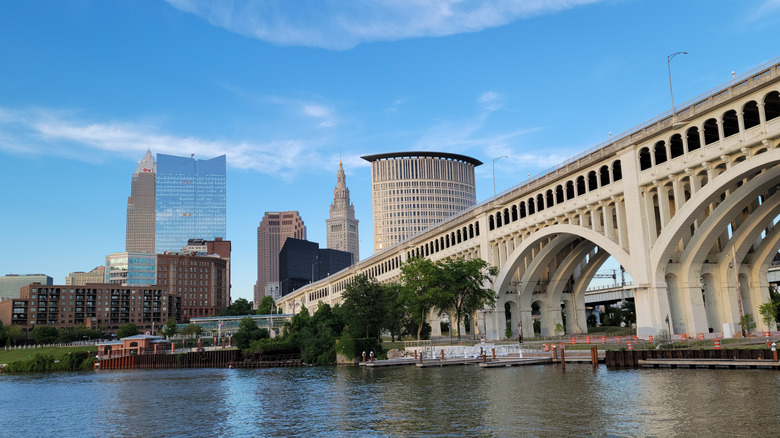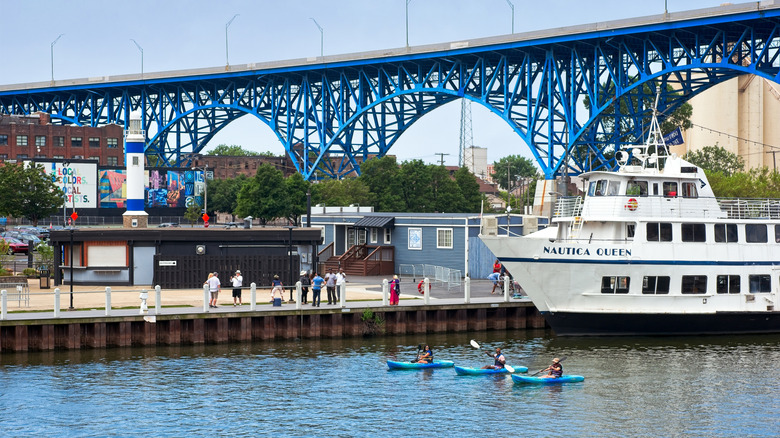Ohio's River Was Once So Polluted It Caught On Fire, But Is Now One Of The Best Urban Paddling Trails In America
Pollution has damaged many areas in the United States, but one Ohio river proves that time and hard work can help reverse the negative effects. The Cuyahoga River in Ohio was once so polluted by the oil industry that it caught on fire. Today, it's recognized as one of the best urban paddling trails in America. The Cuyahoga River runs through northeast Ohio, passing through Cleveland and Akron, before feeding into Lake Erie. When Cleveland's industrial and population growth took off in the late 1800s and early 1900s, the river became heavily polluted. Between 1868 and 1969, the Cuyahoga River caught on fire at least 14 times, but it was the fire of 1969 that led to major change.
On June 22, 1969, an oil slick on the Cuyahoga River caught on fire and was extinguished after about thirty minutes. It was less serious than many prior fires, but thanks to the burgeoning environmental movement, the fire gained national attention and was covered in Time and National Geographic. According to Smithsonian magazine, "The nation, it seemed, had suddenly woken up to the realities of industrial pollution, and the Cuyahoga River was the symbol of calamity."
Cleaning up the Cuyahoga River
Efforts to clean up the Cuyahoga River actually began before the 1969 fire. Voters approved a $100 million bond program to fund cleanup in 1968, and that same year, the city worked to improve its sewage system to reduce pollution. However, Cleveland mayor Carl Stokes and his brother Louis Stokes, a member of the House of Representatives, used the 1969 fire as an opportunity to push for environmental regulation at a national level. Today, the 1969 Cuyahoga River Fire is recognized as leading to the Clean Water Act, the Environmental Protection Agency, and Earth Day. In 2025, the BBC called it "the burning river that fueled a US green movement."
The cleanup progress was slow and steady. Between 1969 and 2009, the Northwest Ohio Regional Sewer District, as well as local companies, collectively spent $3.5 billion to reduce pollution on the river. This involved building a new wastewater system and removing dams. "This didn't happen because a bunch of wild-haired hippies protested down the street," John Perrecone, a manager of Great Lakes programs for the EPA, told the New York Times in 2009. "This happened because a lot of citizens up and down the watershed worked hard for 40 years to improve the river."
While the river has improved drastically, there's still work to be done. In August 2020, the Cuyahoga River caught fire for the first time since 1969 after a fuel tanker accident leaked into the river via storm drains. The fire only lasted five minutes, but it earned national press attention. Outside Magazine wrote, "Like the 1969 fire, this one could serve as a warning of the peril our environment faces, because the last 51 years have not been marked only by progress," pointing to recent changes to the Clean Water Act.
Activities on the Cuyahoga River
Today, much of the Cuyahoga River is popularly used for outdoor recreation — especially paddling. In 2023, USA Today recognized the Cuyahoga River Water Trail as the best urban kayaking spot in the United States, spotlighting the 20-mile segment that runs through Cleveland into Lake Erie. "The river is calm, the paddling is easy, and the sightseeing is spectacular," wrote one Tripadvisor reviewer.
Cuyahoga Valley National Park offers opportunities to engage with the river in a less urban setting. Located in Peninsula, an under-the-radar small town with impressive views that's located between Akron and Cleveland, it's Ohio's only national park and is known for stunning waterfall views. Cuyahoga Valley National Park contains 33,000 acres centered on the Cuyahoga River, with over 125 miles of hiking trails. Biking, paddling, birding, horseback riding, golfing, and fishing are all popular activities. And yes, you can eat the fish. In 2019, federal officials stated that fish caught in the river are now safe to eat. At the time, Gov. Mike DeWine said, "This is an example of the progress that can be achieved when you collaborate and dedicate resources to improving the quality of water in our state."


